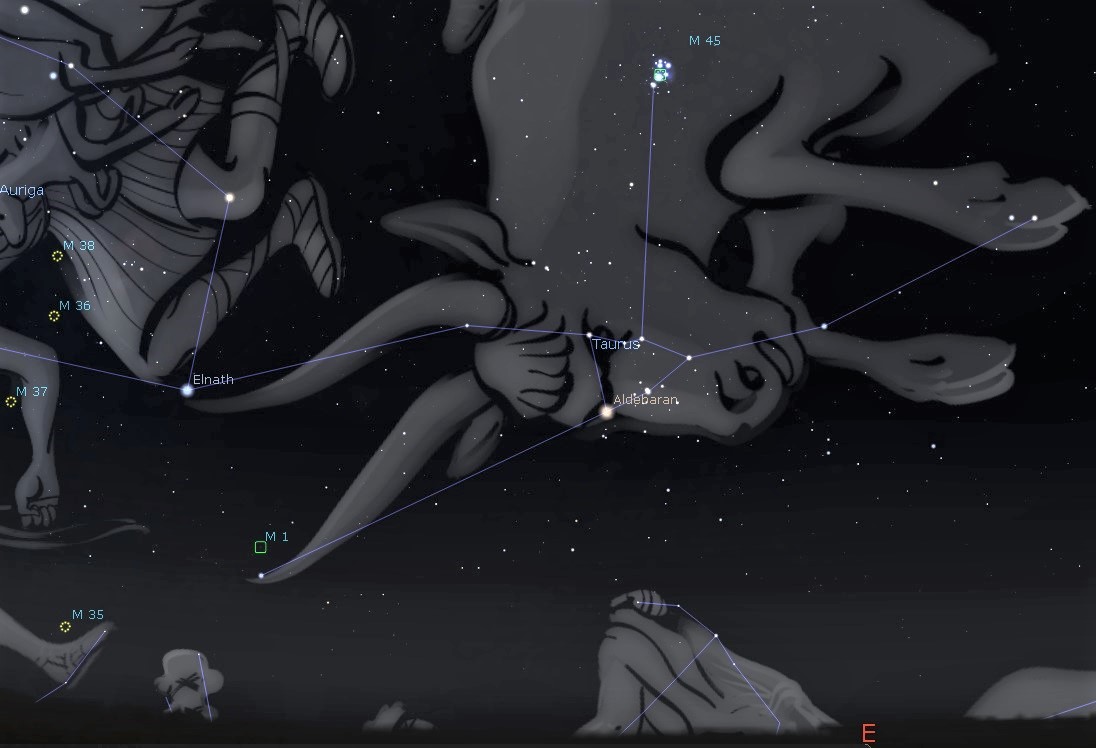This Week’s Sky at a Glance, 2020 December 5 – 12
~by Curt Nason
The constellation of Taurus the Bull has completely cleared the eastern horizon by 6:30 pm this week. It is distinguished by two relatively close star clusters: the compact dipper-shaped Pleiades in the bull’s shoulder and the V-shaped Hyades that forms the bull’s face. The bright orange star Aldebaran anchors one side of the V, representing the bull’s fiery eye, but it is not actually part of the cluster as it is much closer. In mythology the Pleiades (aka the Seven Sisters) and the Hyades were half-sisters; daughters of Atlas, who obviously didn’t spend all his time holding up the sky.
Starting from the apex of the Hyades, extend each side of the V outward to a star. These stars are the tips of the bull’s horns. The upper star is Elnath, which forms one of the corners of Auriga the Charioteer although it is officially part of Taurus. The other horn star has a famous dim neighbour, which is about one degree away and slightly to the right of a line joining the horns. Called the Crab Nebula or M1 for being the first entry in Charles Messier’s 18th century catalogue, this little fuzzy patch is a gaseous supernova remnant. The supernova, a death-explosion of a giant star, was seen in daylight for three weeks in 1054. I have seen M1 in a transparent sky with binoculars but a scope gives a better view.
This Week in the Solar System
Saturday’s sunrise in Moncton is at 7:45 am and sunset will occur at 4:33 pm, giving 8 hours, 48 minutes of daylight (7:48 am and 4:41 pm in Saint John). Next Saturday the Sun will rise at 7:52 am and set at 4:33 pm, giving 8 hours, 41 minutes of daylight (7:54 am and 4:41 pm in Saint John).
The Moon is at third quarter on Monday and it will be approaching Venus next Saturday. Also by next Saturday Jupiter will have moved to within one degree of Saturn and they will remain that close for most of the month. Both planets will be within a low to medium magnification view of telescopes, but their low altitude will make it difficult to expect a sharp view. Mars remains close enough all month to offer views of its surface features in a telescope, and high enough in early evening for higher magnification observing. Venus has just crossed between Zubenelgenubi and Zubeneschamali, the two brightest stars of Libra, which were considered the celestial equivalent of the promontories defining the Strait of Gibraltar and which ancient Greeks called the Pillars of Hercules. Mercury is too close to the Sun for observing. By the end of the week we should start seeing an uptick in meteors as the reliable Geminid shower peaks on December 13/14.
With astronomy meetings and outreach activities on hold, you can watch the local Sunday Night Astronomy Show at 8 pm and view archived shows.
Questions? Contact Curt Nason.

